sensor Peugeot 3008 Hybrid 4 2011 Owner's Manual
[x] Cancel search | Manufacturer: PEUGEOT, Model Year: 2011, Model line: 3008 Hybrid 4, Model: Peugeot 3008 Hybrid 4 2011Pages: 280, PDF Size: 16.5 MB
Page 5 of 280
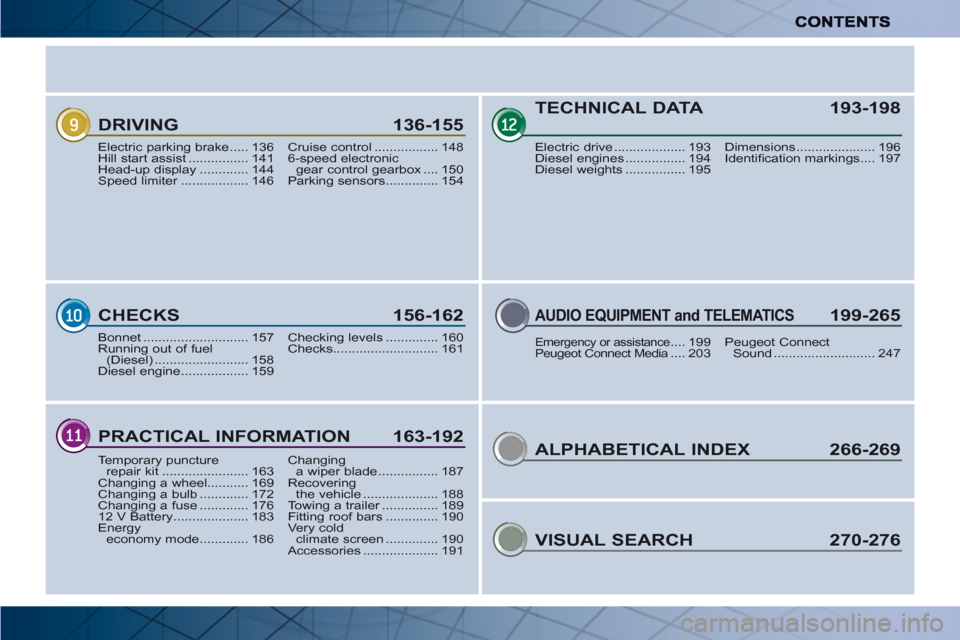
ALPHABETICAL INDEX 266-269
DRIVING 136-155
CHECKS 156-162
PRACTICAL INFORMATION 163-192
TECHNICAL DATA 193-198
AUDIO EQUIPMENT and TELEMATICS 199-265
Electric parking brake.....136Hill start assist................141Head-up display.............144Speed limiter..................r146
Cruise control .................1486-speed electronicgear control gearbox....150Parking sensors ..............154
Bonnet............................157Running out of fuel (Diesel).........................158Diesel engine..................159
Checking levels ..............160Checks............................161
Temporary puncture repair kit .......................163Changing a wheel...........169Changing a bulb.............172Changing a fuse .............17612 V Battery....................183Energy economy mode.............186
Changinga wiper blade ................187Recoveringthe vehicle....................188Towing a trailer...............r189Fitting roof bars ..............190Very cold climate screen..............190Accessories....................191
Electric drive ...................193Diesel engines................194Diesel weights................195
Dimensions .....................196Identification markings....197
VISUAL SEARCH 270-276
Emergency or assistance....199Peugeot Connect Media....203Peugeot Connect Sound ...........................247
Page 11 of 280
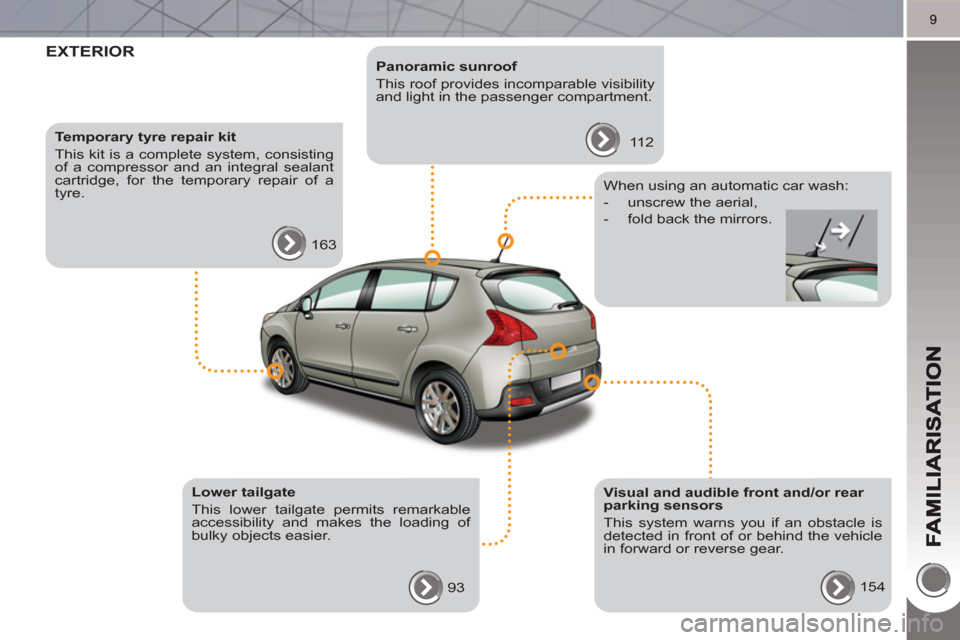
9
EXTERIOR
Panoramic sunroof
This roof provides incomparable visibility
and light in the passenger compartment.
112
Temporary tyre repair kit
This kit is a complete system, consisting
of a compressor and an integral sealant
cartridge, for the temporary repair of a
tyre.
163
Lower tailgate
This lower tailgate permits remarkable
accessibility and makes the loading of
bulky objects easier.
93
Visual and audible front and/or rear
parking sensors
This system warns you if an obstacle is
detected in front of or behind the vehicle
in forward or reverse gear.
154
When using an automatic car wash:
- unscrew the aerial,
- fold back the mirrors.
Page 12 of 280
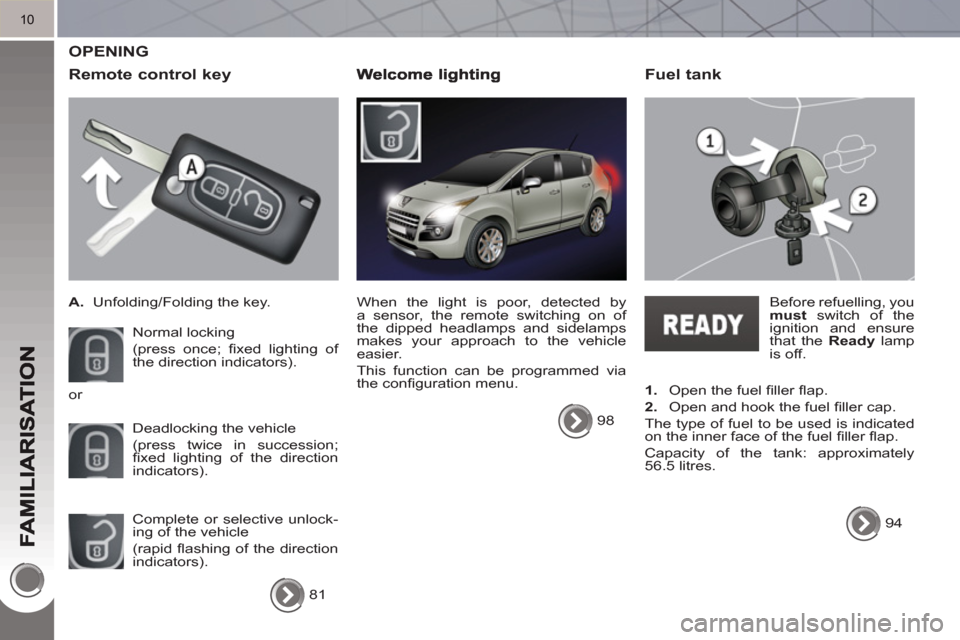
10
OPENING
Remote control ke
y
A.
Unfolding/Folding the key.
Normal locking
(press once; fi xed lighting of
the direction indicators).
Deadlocking the vehicle
(press twice in succession;
fi xed lighting of the direction
indicators).
Complete or selective unlock-
ing of the vehicle
(rapid fl ashing of the direction
indicators). or
81 When the light is poor, detected by
a sensor, the remote switching on of
the dipped headlamps and sidelamps
makes your approach to the vehicle
easier.
This function can be programmed via
the confi guration menu.
98
94
Fuel tank
Before refuelling, you
must
switch of the
ignition and ensure
that the Ready
lamp
is off.
1.
Open the fuel fi ller fl ap.
2.
Open and hook the fuel fi ller cap.
The type of fuel to be used is indicated
on the inner face of the fuel fi ller fl ap.
Capacity of the tank: approximately
56.5 litres.
Page 15 of 280
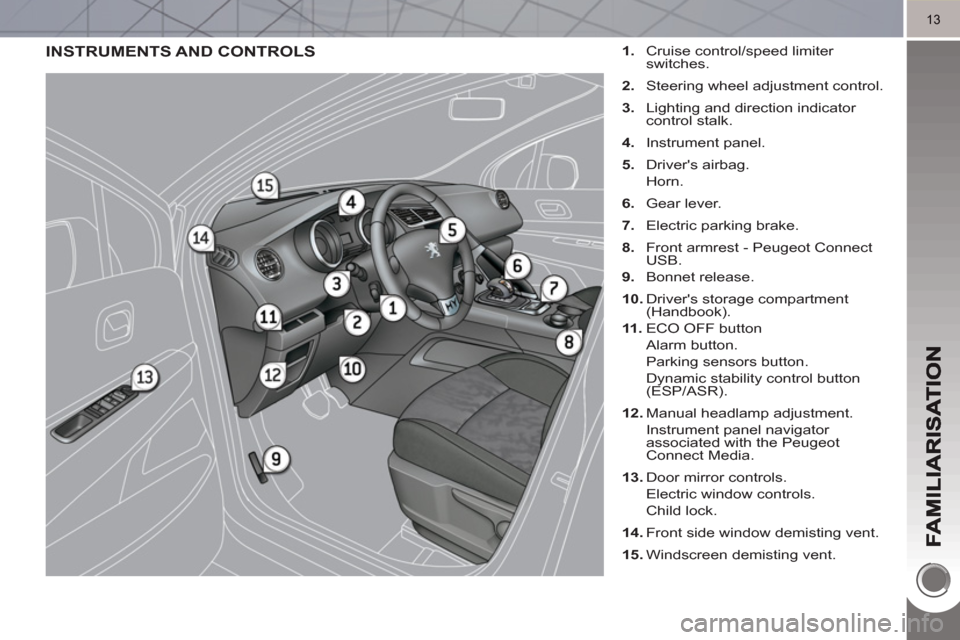
13
INSTRUMENTS AND CONTROLS
1.
Cruise control/speed limiter
switches.
2.
Steering wheel adjustment control.
3.
Lighting and direction indicator
control stalk.
4.
Instrument panel.
5.
Driver's airbag.
Horn.
6.
Gear lever.
7.
Electric parking brake.
8.
Front armrest - Peugeot Connect
USB.
9.
Bonnet release.
10.
Driver's storage compartment
(Handbook).
11 .
ECO OFF button
Alarm button.
Parking sensors button.
Dynamic stability control button
(ESP/ASR).
12.
Manual headlamp adjustment.
Instrument panel navigator
associated with the Peugeot
Connect Media.
13.
Door mirror controls.
Electric window controls.
Child lock.
14.
Front side window demisting vent.
15.
Windscreen demisting vent.
Page 21 of 280
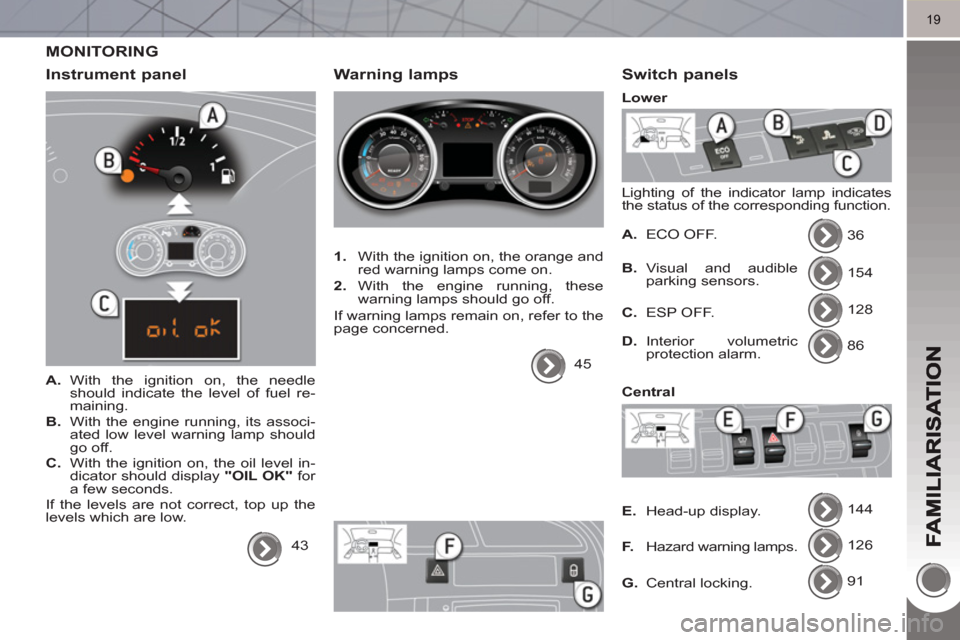
19
MONITORING
Instrument
panel
A.
With the ignition on, the needle
should indicate the level of fuel re-
maining.
B.
With the engine running, its associ-
ated low level warning lamp should
go off.
C.
With the ignition on, the oil level in-
dicator should display "OIL OK"
for
a few seconds.
If the levels are not correct, top up the
levels which are low.
43
Warning lamps
1.
With the ignition on, the orange and
red warning lamps come on.
2.
With the engine running, these
warning lamps should go off.
If warning lamps remain on, refer to the
page concerned.
45
Switch panels
Lighting of the indicator lamp indicates
the status of the corresponding function.
A.
ECO OFF.
36
154
128
86
144
126
91
B.
Visual and audible
parking sensors.
C.
ESP OFF.
D.
Interior volumetric
protection alarm.
E.
Head-up display.
F.
Hazard warning lamps.
G.
Central locking.
Lower
Central
Page 70 of 280
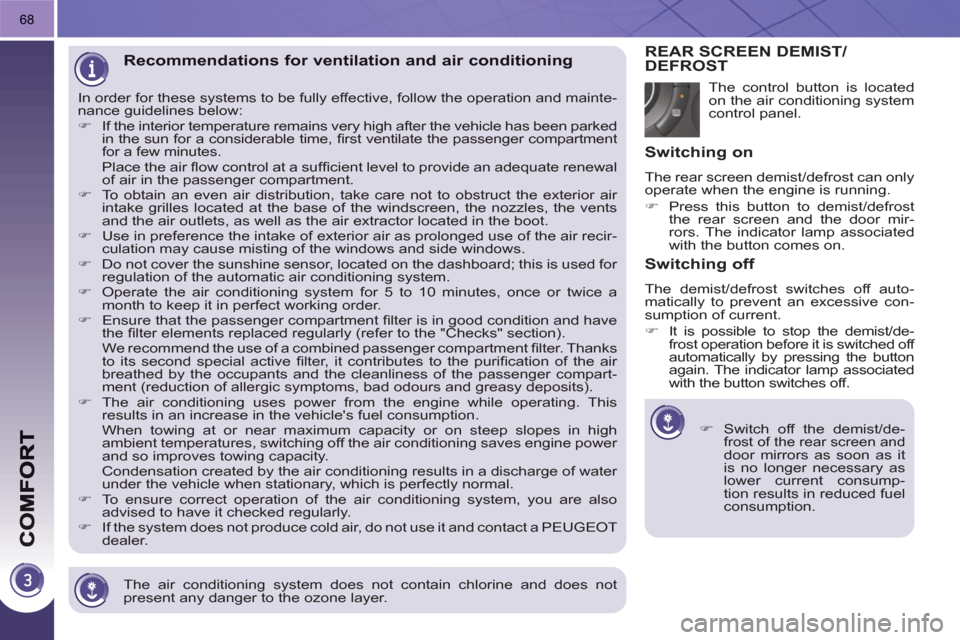
68
The air conditioning system does not contain chlorine and does not
present any danger to the ozone layer.
Recommendations for ventilation and air conditioning
In order for these systems to be fully effective, follow the operation and mainte-
nance guidelines below:
�)
If the interior temperature remains very high after the vehicle has been parked
in the sun for a considerable time, fi rst ventilate the passenger compartment
for a few minutes.
Place the air fl ow control at a suffi cient level to provide an adequate renewal
of air in the passenger compartment.
�)
To obtain an even air distribution, take care not to obstruct the exterior air
intake grilles located at the base of the windscreen, the nozzles, the vents
and the air outlets, as well as the air extractor located in the boot.
�)
Use in preference the intake of exterior air as prolonged use of the air recir-
culation may cause misting of the windows and side windows.
�)
Do not cover the sunshine sensor, located on the dashboard; this is used for
regulation of the automatic air conditioning system.
�)
Operate the air conditioning system for 5 to 10 minutes, once or twice a
month to keep it in perfect working order.
�)
Ensure that the passenger compartment fi lter is in good condition and have
the fi lter elements replaced regularly (refer to the "Checks" section).
We recommend the use of a combined passenger compartment fi lter. Thanks
to its second special active fi lter, it contributes to the purifi cation of the air
breathed by the occupants and the cleanliness of the passenger compart-
ment (reduction of allergic symptoms, bad odours and greasy deposits).
�)
The air conditioning uses power from the engine while operating. This
results in an increase in the vehicle's fuel consumption.
When towing at or near maximum capacity or on steep slopes in high
ambient temperatures, switching off the air conditioning saves engine power
and so improves towing capacity.
Condensation created by the air conditioning results in a discharge of water
under the vehicle when stationary, which is perfectly normal.
�)
To ensure correct operation of the air conditioning system, you are also
advised to have it checked regularly.
�)
If the system does not produce cold air, do not use it and contact a PEUGEOT
dealer. The control button is located
on the air conditioning system
control panel.
REAR SCREEN DEMIST/DEFROST
�)
Switch off the demist/de-frost of the rear screen and door mirrors as soon as it
is no longer necessary as
lower current consump-
tion results in reduced fuel
consumption.
Switching on
The rear screen demist/defrost can only
operate when the engine is running.
�)
Press this button to demist/defrost
the rear screen and the door mir-
rors. The indicator lamp associated
with the button comes on.
Switching off
The demist/defrost switches off auto-
matically to prevent an excessive con-
sumption of current.
�)
It is possible to stop the demist/de-
frost operation before it is switched off
automatically by pressing the button
again. The indicator lamp associated
with the button switches off.
Page 82 of 280
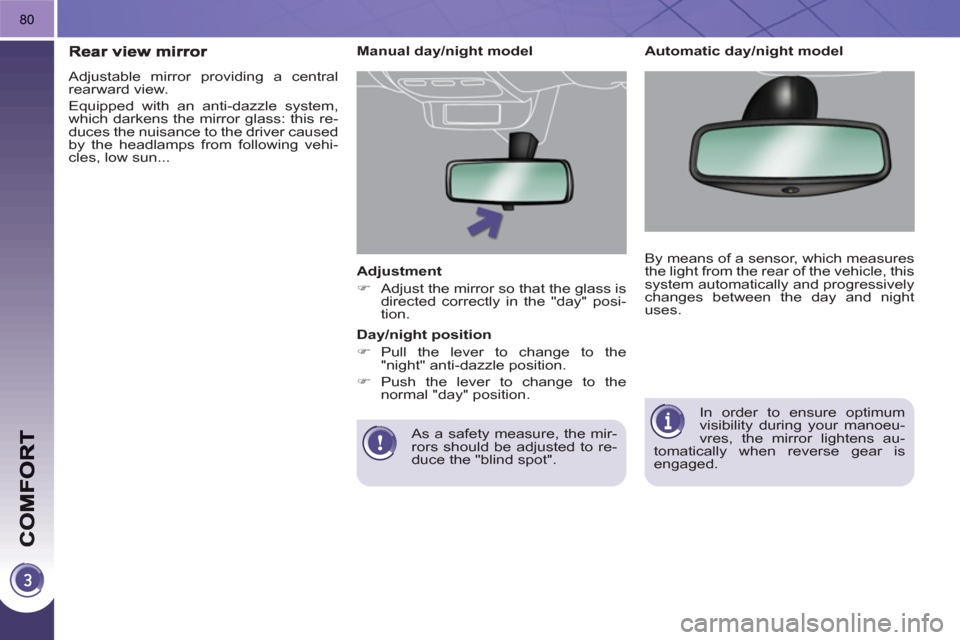
80
Adjustment
�)
Adjust the mirror so that the glass is
directed correctly in the "day" posi-
tion.
As a safety measure, the mir-
rors should be adjusted to re-
duce the "blind spot".
Manual day/night model
Day/night position
�)
Pull the lever to change to the
"night" anti-dazzle position.
�)
Push the lever to change to the
normal "day" position.
Adjustable mirror providing a central
rearward view.
Equipped with an anti-dazzle system,
which darkens the mirror glass: this re-
duces the nuisance to the driver caused
by the headlamps from following vehi-
cles, low sun...
In order to ensure optimum
visibility during your manoeu-
vres, the mirror lightens au-
tomatically when reverse gear is
engaged.
Automatic day/night model
By means of a sensor, which measures
the light from the rear of the vehicle, this
system automatically and progressively
changes between the day and night
uses.
Page 100 of 280
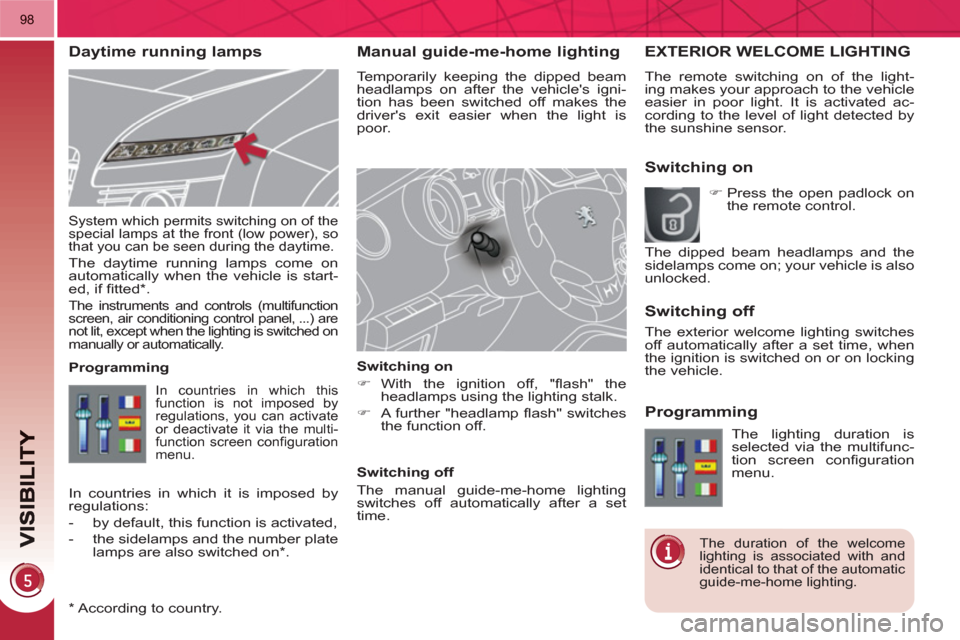
98
Manual guide-me-home lighting
Temporarily keeping the dipped beam
headlamps on after the vehicle's igni-
tion has been switched off makes the
driver's exit easier when the light is
poor.
Switching on
�)
With the ignition off, "fl ash" the
headlamps using the lighting stalk.
�)
A further "headlamp fl ash" switches
the function off.
Switching off
The manual guide-me-home lighting
switches off automatically after a set
time.
System which permits switching on of the
special lamps at the front (low power), so
that you can be seen during the daytime.
The daytime running lamps come on
automatically when the vehicle is start-
ed, if fi tted * .
The instruments and controls (multifunction
screen, air conditioning control panel, ...) are
not lit, except when the lighting is switched on
manually or automatically.
*
According to country.
EXTERIOR WELCOME LIGHTING
The remote switching on of the light-
ing makes your approach to the vehicle
easier in poor light. It is activated ac-
cording to the level of light detected by
the sunshine sensor.
Switching on
Switchin
g off
Programming
In countries in which this
function is not imposed by
regulations, you can activate
or deactivate it via the multi-
function screen confi guration
menu.
Programming
The lighting duration is
selected via the multifunc-
tion screen confi guration
menu.
The duration of the welcome
lighting is associated with and
identical to that of the automatic
guide-me-home lighting.
In countries in which it is imposed by
regulations:
- by default, this function is activated,
- the sidelamps and the number plate
lamps are also switched on * .
�)
Press the open padlock on
the remote control.
The dipped beam headlamps and the
sidelamps come on; your vehicle is also
unlocked.
The exterior welcome lighting switches
off automatically after a set time, when
the ignition is switched on or on locking
the vehicle.
Daytime running lamps
Page 101 of 280

99
In fog or snow, the sunshine
sensor may detect suffi cient
light. Therefore, the lighting
will not come on automatically.
Do not cover the sunshine sensor,
coupled with the rain sensor and lo-
cated in the centre of the windscreen
behind the rear view mirror; the as-
sociated functions would no longer
be controlled.
Associated with the automatic
"Guide-me-home" lighting
Association with the automatic lighting
provides the "guide-me-home" lighting
with the following additional options:
- selection of the lighting duration of
15, 30 or 60 seconds in the vehicle
parameters on the multifunction
screen confi guration menu,
-
automatic activation of "guide-me-home"
lighting when automatic lighting is in
operation.
Automatic illumination of headlamps
The sidelamps and dipped beam head-
lamps are switched on automatically,
without any action on the part of the
driver, when a low level of external light
is detected or in certain cases of activa-
tion of the windscreen wipers.
As soon as the brightness returns to a
suffi cient level or after the windscreen
wipers are switched off, the lamps are
switched off automatically.
Activation
�)
Turn the ring to the "AUTO"
position.
The automatic illumination of head-
lamps is accompanied by a mes-
sage on the multifunction screen.
Deactivation
�)
Turn the ring to another position.
Deactivation is accompanied by
a message on the multifunction
screen.
Operating fault
In the event of a malfunction of
the sunshine sensor, the light-
ing comes on, this warning
lamp is displayed on the instru-
ment panel and/or a message appears
on the multifunction screen, accompa-
nied by an audible signal.
Consult a PEUGEOT dealer.
MANUAL ADJUSTMENT OF
HALOGEN HEADLAMPS
The initial setting is position "0"
.
To avoid causing a nuisance to other
road users, the height of the halogen
headlamps should be adjusted accord-
ing to the load in the vehicle.
0.
1 or 2 people in the front seats.
-.
3 people.
1.
5 people.
-.
Intermediate setting.
2.
5 people + maximum authorised
load.
-.
Intermediate setting.
3.
Driver + maximum authorised load.
Page 104 of 280

102
Special position of the
windscreen wipersAutomatic rain sensitive
windscreen wipers
The windscreen wipers operate automati-
cally, without any action on the part of the
driver, if rain is detected (sensor behind
the rear view mirror), adapting their speed
to the intensity of the rainfall.
Activation
This is controlled manually by the driver
by pushing the stalk downwards to the
"AUTO"
position.
It is accompanied by a message on the
multifunction screen. This position permits release of the
windscreen wiper blades.
It is used for cleaning or replacement
of the blades. It can also be useful, in
winter, to detach the blades from the
windscreen.
In the moment following switching the
ignition off, any action on the stalk posi-
tions the wipers vertically on the wind-
screen.
Do not cover the rain sensor,
linked with the sunshine sen-
sor and located in the centre
of the windscreen behind the rear
view mirror.
Switch off the automatic rain sensi-
tive wipers when using an automatic
car wash.
In winter, to avoid damaging the wip-
er blades, it is advisable to wait until
the windscreen is completely clear of
ice before activating the automatic
rain sensitive wipers.
The automatic rain sensitive
wipers must be reactivated if
the ignition has been off for
more than one minute, by pushing
the stalk downwards.
Switching off
This is controlled manually by the driver
by moving the stalk upwards then re-
turning it to position "0"
.
It is accompanied by a message on the
multifunction screen.
Operating fault
If an automatic wiping malfunction occurs,
the wipers will operate in intermittent mode.
Have it checked by a PEUGEOT dealer.
To park the wipers after this
has been done, switch on the
ignition and operate the stalk.
To maintain the effectiveness of the
"fl at-blade" wiper blades, it is advis-
able to:
- handle them with care,
- clean them regularly using soapy
water,
- avoid using them to retain card-
board on the windscreen,
- replace them at the fi rst signs of
wear.